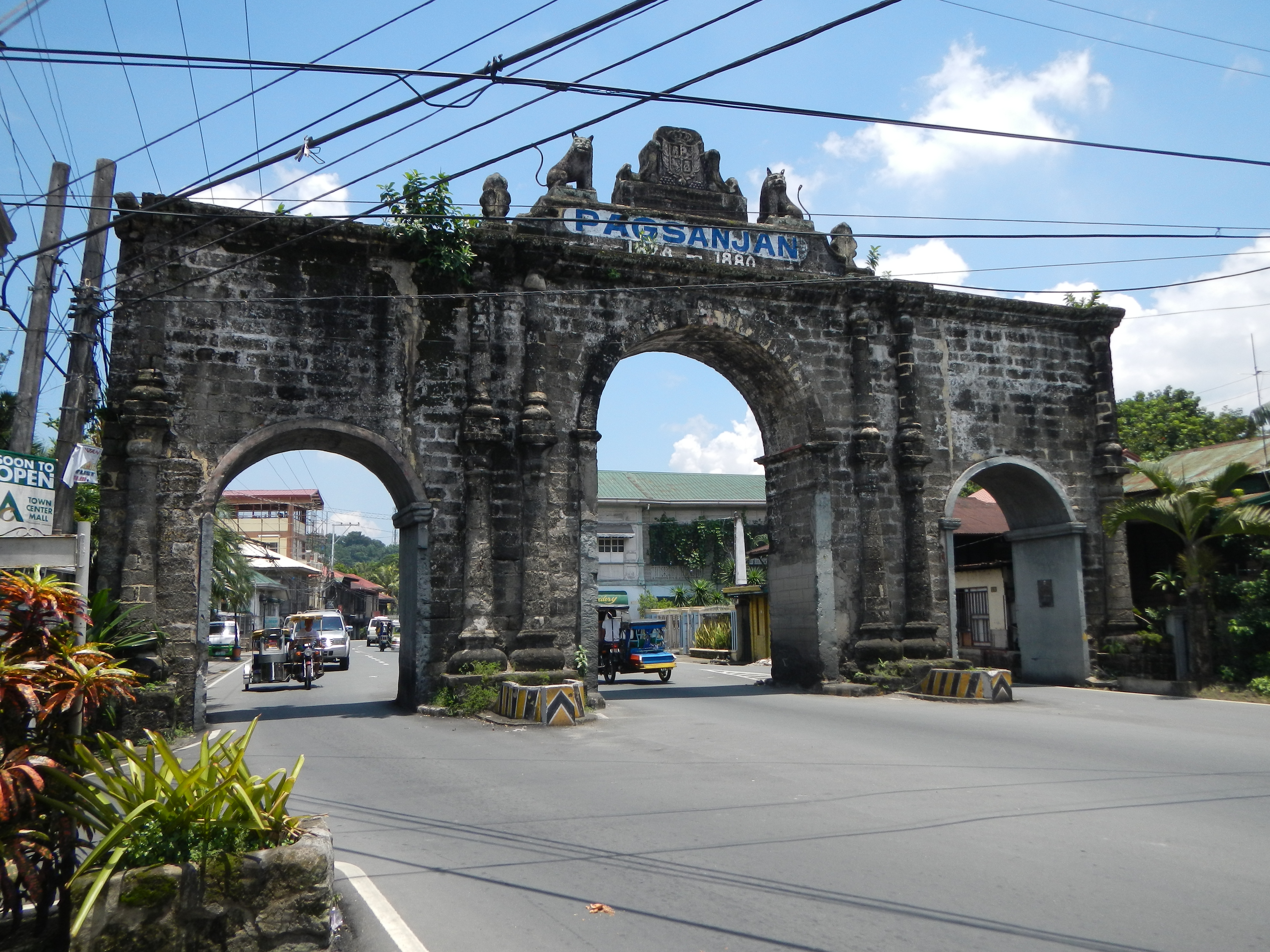|
Pagsanjan River
The Bumbungan River ( tl, Ilog Bumbungan) is a river in the province of Laguna in the Philippines. It is commonly referred to as the Pagsanjan River because of the popularity of the municipality of Pagsanjan and Pagsanjan Falls, one of the province's tourist destinations. The municipality of Pagsanjan was named so because it is where the Balanac River, originating from Mount Banahaw, joins the Bumbungan. Its old name, ''Pinagsangahan'', which literally means branching, was changed to ''Pagsanjan'' during the Spanish Colonial Era. The Bumbungan River originates from the Sierra Madre mountains, in the highlands of Cavinti, flowing through Pagsanjan and ending in Lumban where it drains to Laguna de Bay, the largest lake in the country. Bumbungan is one of 21 major tributaries of the lake and responsible for up to 35% of the water that flows into the lake. It is regularly monitored by the Laguna Lake Development Authority (LLDA) through one of its 15 river monitoring stations. ... [...More Info...] [...Related Items...] OR: [Wikipedia] [Google] [Baidu] |
Pagsanjan
Pagsanjan (pronounced ''PAG-sang-han''), officially the Municipality of Pagsanjan ( tgl, Bayan ng Pagsanjan), is a 3rd class municipality in the province of Laguna, Philippines. According to the 2020 census, it has a population of 44,327 people. Situated from Santa Cruz and southeast of Manila, this town can reach via Manila East Road or Slex. Pagsanjan is the tourist capital of Laguna and is the home of the Bangkero Festival held every March. The ''bangkeros'' are tour guides who steer boats along the river to Pagsanjan Falls (also called Magdapio Falls), for which the town is well known but is actually in neighboring Cavinti. Pagsanjan was the capital of the province of Laguna for 170 years (1688–1858) during which the town prospered as the commercial, cultural and learning center of the province. Etymology Pagsanjan is located in the riparian delta formed by the confluence of the Balanac and Bumbungan rivers. Originally called ''Pinágsangahán'' ("branching" or " ... [...More Info...] [...Related Items...] OR: [Wikipedia] [Google] [Baidu] |
Lumot Lake
Lumot Lake, also known as Sierra Lake, is a man-made water reservoir located in the towns of Cavinti and Lumban of Laguna province, in the Sierra Madre Mountains of the Philippines. The lake was created when Lumot Dam, an embankment dam, was constructed damming the Lumot River, creating an auxiliary water reservoir for Lake Caliraya as part of the ''Kalayaan Pumped-Storage Hydroelectric Plant''.Task Committee on Pumped Storage (1996). "Hydroelectric Pump Storage Technology: International Experience", p.28. American Society of Civil Engineers. The waters between the two lakes are conveyed by a penstock. Lumot Lake is less developed than the bigger Lake Caliraya but both lakes are popular spots for water sports and largemouth bass The largemouth bass (''Micropterus salmoides'') is a carnivorous freshwater gamefish in the Centrarchidae ( sunfish) family, a species of black bass native to the eastern and central United States, southeastern Canada and northern Mexico, bu .. ... [...More Info...] [...Related Items...] OR: [Wikipedia] [Google] [Baidu] |
Rapids
Rapids are sections of a river where the river bed has a relatively steep gradient, causing an increase in water velocity and turbulence. Rapids are hydrological features between a ''run'' (a smoothly flowing part of a stream) and a ''cascade''. Rapids are characterized by the river becoming shallower with some rocks exposed above the flow surface. As flowing water splashes over and around the rocks, air bubbles become mixed in with it and portions of the surface acquire a white color, forming what is called "whitewater". Rapids occur where the bed material is highly resistant to the erosive power of the stream in comparison with the bed downstream of the rapids. Very young streams flowing across solid rock may be rapids for much of their length. Rapids cause water aeration of the stream or river, resulting in better water quality. Rapids are categorized in classes, generally running from I to VI. A Class 5 rapid may be categorized as Class 5.1-5.9. While Class I rapids are eas ... [...More Info...] [...Related Items...] OR: [Wikipedia] [Google] [Baidu] |
Pagsanjan Gorge National Park
The Pagsanjan Gorge National Park is a national park and tourist zone located in the province of Laguna in the Philippines, approximately southeast of Manila. It protects an area of around a series of gorges on the Bumbungan River which leads to Pagsanjan Falls. It is one of the oldest parks in the country and one of two protected areas in Laguna. It is situated in the municipalities of Pagsanjan, Cavinti and Lumban. History The park was first established in 1904 through Executive Order No. 33 signed by Civil Governor Luke Edward Wright. The Caliraya Falls Reserve covered and was initially set aside for the development of water power from the falls of the Caliraya River. Executive Order No. 65 by Governor-General William Cameron Forbes in 1913 reduced its size to . In 1939, through Proclamation No. 392 signed by President Manuel Luis Quezon, the reserve was reclassified and renamed to Pagsanjan Gorge National Park with its area further reduced to its present size. The natio ... [...More Info...] [...Related Items...] OR: [Wikipedia] [Google] [Baidu] |
Manila
Manila ( , ; fil, Maynila, ), officially the City of Manila ( fil, Lungsod ng Maynila, ), is the capital of the Philippines, and its second-most populous city. It is highly urbanized and, as of 2019, was the world's most densely populated city proper. Manila is considered to be a global city and rated as an Alpha – City by Globalization and World Cities Research Network (GaWC). It was the first chartered city in the country, designated as such by the Philippine Commission Act 183 of July 31, 1901. It became autonomous with the passage of Republic Act No. 409, "The Revised Charter of the City of Manila", on June 18, 1949. Manila is considered to be part of the world's original set of global cities because its commercial networks were the first to extend across the Pacific Ocean and connect Asia with the Spanish Americas through the galleon trade; when this was accomplished, it marked the first time in world history that an uninterrupted chain of trade routes circling ... [...More Info...] [...Related Items...] OR: [Wikipedia] [Google] [Baidu] |
Laguna Lake Development Authority
The Laguna Lake Development Authority (LLDA), one of the attached agencies of the Department of Environment and Natural Resources (DENR), is responsible for the preservation, development, and sustainability of Laguna de Bay (Laguna Lake) and its 21 major tributary rivers. The Laguna Lake Development Authority was created by virtue of Republic Act No. 4850 (as amended by Presidential Decree No. 813). Since 1993, the LLDA has been attached to the DENR pursuant to Executive Order No. 149 for administrative supervision and policy alignment. History The Laguna Lake Development Authority (LLDA) was established in 1966 as a quasi-government agency that leads, promotes, and accelerates sustainable development in the Laguna de Bay Region. Regulatory and law-enforcement functions are carried out with provisions on environmental management, particularly on water quality monitoring, conservation of natural resources, and community-based natural resource management. The LLDA on August 7 ... [...More Info...] [...Related Items...] OR: [Wikipedia] [Google] [Baidu] |
Tributaries
A tributary, or affluent, is a stream or river that flows into a larger stream or main stem (or parent) river or a lake. A tributary does not flow directly into a sea or ocean. Tributaries and the main stem river drain the surrounding drainage basin of its surface water and groundwater, leading the water out into an ocean. The Irtysh is a chief tributary of the Ob river and is also the longest tributary river in the world with a length of . The Madeira River is the largest tributary river by volume in the world with an average discharge of . A confluence, where two or more bodies of water meet, usually refers to the joining of tributaries. The opposite to a tributary is a distributary, a river or stream that branches off from and flows away from the main stream. PhysicalGeography.net, Michael Pidwirny & Scott ... [...More Info...] [...Related Items...] OR: [Wikipedia] [Google] [Baidu] |
Gregorio F
Gregorio is a masculine given name and a surname. It may refer to: Given name * Gregorio Conrado Álvarez (1925–2016), Uruguayan army general and de facto President of Uruguay from 1981 until 1985 * Gregorio Álvarez (historian) (1889–1986), Argentine historian, physician and writer * Gregorio S. Araneta (1869–1930), Filipino lawyer, businessman and nationalist * Gregorio Benito (1946–2020), Spanish retired footballer * Gregorio C. Brillantes, Filipino writer * Gregorio di Cecco (c. 1390–after 1424), Italian painter * Gregório Nunes Coronel (c. 1548–c. 1620), Portuguese theologian, writer and preacher * Gregorio Cortez (1875–1916), Mexican-American tenant farmer and folk hero * Gregorio De Gregori (), printer in Renaissance Venice * Gregorio del Pilar (1875–1899), Philippine Revolutionary Forces general during the Philippine Revolution and the Philippine–American War * Gregorio De Ferrari (c. 1647–1726), Italian painter * Gregorio López (writer) (1895–1 ... [...More Info...] [...Related Items...] OR: [Wikipedia] [Google] [Baidu] |
History Of The Philippines (1521-1898)
Earliest hominin activity in the Philippine archipelago is dated back to at least 709,000 years ago. ''Homo luzonensis'', a species of archaic humans, was present on the island of Luzon at least 67,000 years ago. The earliest known anatomically modern human was from Tabon Caves in Palawan dating about 47,000 years. Negrito groups were the first inhabitants to settle in the prehistoric Philippines. By around 3000 BC, seafaring Austronesians, who form the majority of the current population, migrated southward from Taiwan. Scholars generally believe that these ethnic and social groups eventually developed into various settlements or polities with varying degrees of economic specialization, social stratification, and political organization. Some of these settlements (mostly those located on major river deltas) achieved such a scale of social complexity that some scholars believe they should be considered early states. This includes the predecessors of modern-day population centers s ... [...More Info...] [...Related Items...] OR: [Wikipedia] [Google] [Baidu] |
Mount Banahaw
Mount Banahaw (; also spelled as Banahao and Banájao) is an active complex volcano on Luzon in the Philippines. The three-peaked volcano is located at the boundary of Laguna and Quezon provinces. It is the highest mountain in both provinces and Calabarzon region, dominating the landscape for miles around. The mountain is considered by many as a holy mountain, thus a ''bundok dambana'', and is popular among pilgrims along with mountain climbers. It is located in a protected area known as Mounts Banahaw–San Cristobal Protected Landscape covering of land. Physical characteristics The andesitic Banahaw volcanic complex is composed of several stratovolcanoes with Mount Banahaw, the largest with a maximum elevation of above mean sea level. The summit is topped by a and deep crater that is breached on the southern rim believed to have been caused by the 1730 eruption. Prior to 1730, a lake occupied the summit crater of Mount Banahaw. The resulting flood destroyed the town ... [...More Info...] [...Related Items...] OR: [Wikipedia] [Google] [Baidu] |
Municipalities Of The Philippines
A municipality ( tl, bayan/munisipalidad; hil, banwa; ceb, lungsod/munisipalidad/munisipyo; pag, baley; pam, balen/balayan; bcl, banwaan; war, bungto/munisipyo; ilo, ili) is a local government unit (LGU) in the Philippines. It is distinct from ''city'', which is a different category of local government unit. Provinces of the Philippines are divided into cities and municipalities, which in turn, are divided into barangays (formerly barrios) – ''villages''. , there are 1,488 municipalities across the country. A municipality is the official term for, and the official local equivalent of, a town, the latter being its archaic term and in all of its literal local translations including Filipino. Both terms are interchangeable. A municipal district is a now-defunct local government unit; previously certain areas were created first as municipal districts before they were converted into municipalities. History The era of the formation of municipalities in the Philippines sta ... [...More Info...] [...Related Items...] OR: [Wikipedia] [Google] [Baidu] |



